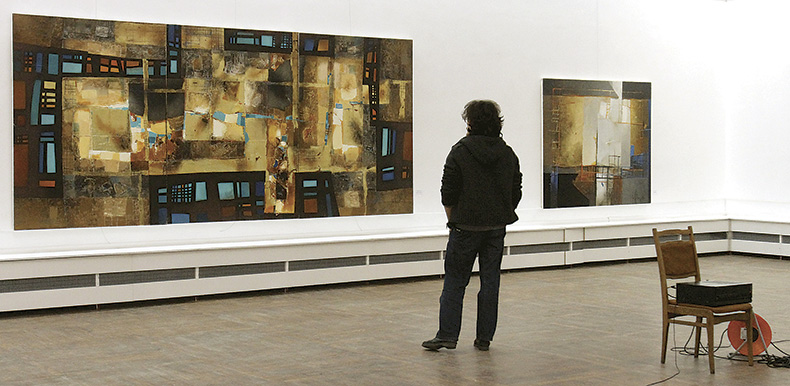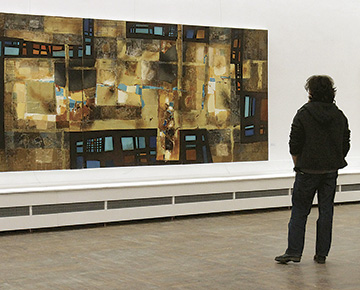or Fine art philosophy upon Anatoly Kuznetsov
Works by the former Soviet Union’s master of non-figurative painting are on show once more at Minsk’s House of Pictures Art Gallery. Interestingly, last year, Anatoly Kuznetsov received the special award of the President of Belarus for figures of culture and art, for his many years of creativity.

At Anatoly Kuznetsov’s personal exhibition
His Valley of Pharaohs exhibition shows the brightest side of Mr. Kuznetsov’s creativity, as well as his interest in the philosophies of ancient cultures and eternal universal values. Created between 2005 and 2006, following a trip to the ancient Egyptian Valley of the Kings, the canvases depict not the familiar architectural sites and hieroglyphs, but non-figurative images. In this way, he bestows them with the solemn anthem of eternity. As the ancient Arab proverb says: ‘Everything in the world is afraid of Time but Time is afraid of Pyramids’. The artist decided to create the cycle ten years ago, being inspired by the wisdom and greatness of the ancient culture. His impressions found expression through warm flowers and shining gold.
Mr. Kuznetsov is one of the oldest Belarusian abstract artists. In the 1980s, he realised that his path lies not in figurative painting, and began his own style. He tells us, “I turned consciously towards non-figurative art, seeking to portray states which defy portrayal: good, evil, heat, cold, emotions and associations.”
Over a period of 35 years, the master has painted around 1,000 pictures, which are held worldwide. He has received the Frantsisk Skorina Medal and, last year, was presented with the Special Presidential Award for figures of culture and art.
Grigory Sitnitsa, the Chairman of the Belarusian Union of Artists, comments, “We usually see awards go to works which are obvious in their intention. We here have an example of the true avant-garde.”
To explain the principles of his creativity, Mr. Kuznetsov invited me to his workshop. Surrounded by the master’s pictures, I saw his works and was able to question him.

Anatoly Kuznetsov
| 
From Valley of Pharaohs series
|
I’ve been preparing for it for a long time. Sooner or later, I would have arrived at abstraction. I learned to think subconsciously; my ear can see as well. Colours swim freely. They can talk: about grief, pleasure, and nuances of feelings.
When you’re working, do you imagine those who’ll view your work, hoping that they’ll understand what you’re trying to express?
Honestly, I concentrate on trying to hear myself. If I can find a response within myself, I can try to convey my emotions to others. Not everyone will understand, but one or two will. I have many acquaintances who want to talk on these topics and, when such communication develops, I explain how I want to reach the viewer.
Being in a niche of your own, do you feel more challenges than other artists?
Sadly, there’s almost no abstract painting now; nothing with rhythm or colour. It’s been the case for some time in Europe. Artists need to accumulate knowledge through experience, finding their true internal state. I know my inner priorities well: they revolve around colour, which finds expression through rhythm, which is tied into systems and trends. You need to avoid idleness, always keeping busy.
When you studied at the Art Institute, was your unique style already developed?
Of course, your style develops over time, and with experience.
Did your teachers understand your vision?
Yes.
Did some fail to understand?
I wasn’t a dissident. I worked and studied in the regular way, but there was almost no information on styles in painting at that time. There were brochures like ‘The Ideology of Bourgeois Culture’, which focused on some trends. I knew about them but didn’t understand. I don’t see myself as an avant-garde artist; I’m not turning anything upside down. However, I do feel that I can reveal myself in this direction and say something new.
What’s your attitude towards exhibitions? Are they an event for you? Or are you indifferent?
No, I’m not indifferent. I organised many shows in the past but, then, fewer people began to attend. I firmly believe an artist needs an exhibition, so they can gain an objective perspective. Your pictures are so close to you, while shows enable them to have a different life. An artist needs to be able to find their direction, and find how to improve, to become more convincing and active. Exhibitions are important for all artists.
An artist spends many hours alone in their studio. What do you tend to think about while working?
I have many thoughts. I often think about giving up, since it takes so much effort to create something worthwhile. You always want to ‘win’ and each new canvas offers that opportunity. It takes physical and moral effort to create a picture, and there are often difficult periods, when colours fail to work well or no image comes to the fore. Then, I consider giving up. However, I go to my studio and begin again, working to achieve my targets and ‘win’.
Do you name your canvases?
Yes, of course. I place them in cycles. My ‘White Suite’ portrays my life and began with figurative works. Later, I created ‘Coloured Spaces’ and ‘Vibrations of Light’. My ‘Valley of Pharaohs’ appeared absolutely unexpectedly, as I never imagined I’d create anything on the Egyptian theme.
Where an artist works in a realistic manner, they tend to portray events, more or less unambiguously. However, you use only colour, and some other elements. Is this adequate?
I use rhythms of expression, which strain at the surface, relax, and pass from one state into another. Colours range from warm to cold and back again. It’s like a directorship, where the concept of space reigns. I work with this space. What is it, and how is it formed? It’s more than points or spots. They move and talk, helping us. Their contact occurs on an intuitive level. The space can be deep and philosophical. There are many spaces and, when they accumulate, it creates a general theme.
If you had time, what would you create?
I draw a lot of emotional pictures. I often go to lakes and commune with nature. This is close to my heart. I never thought that I’d ‘win’ on coming to Belarus but it’s my place. My ‘Memories of Kurosawa’ was inspired by my time sitting by a lake, looking at the old reeds, with the snow falling in large flakes. It seemed to hang rather than fall. For some reason, I connected my feelings with Kurosawa, who was a neorealist, working in contrasts. Belarus is my place, where I perceive vibrations connected not only with colours but hearing and my sense of smell.
Would you perceive such feelings in some other place?
Local colouring is special. I’ve been brought up with it.
Most of your works must come from your imagination, and your soul. Only a small share must be inspired by external sources, but perhaps, I’m wrong. What most inspires you as an abstract artist?
It’s impossible to say why something happens in one way and not in another. We see things which we can’t always explain. Think of how much happens in a single day. All the connected emotions materialise, and I begin my work. I’ve trained myself this way so it’s natural for me. Of course, I can easily draw trees, houses or reflections in water. I draw from nature but do my best to see what others fail to notice. I must see that which most do not.
Do you ever edit your works?
Of course; I’m very whimsical with colour and work spontaneously. Complex processes take place, and I need to think consciously. I might spend an hour or two without a brush, simply thinking and watching. It’s very useful. Being an artist is not a profession: it’s a state. You need to know how to communicate with yourself. There’s no benefit to being in the public eye. It’s a mistake. I don’t want to be fashionable. I want to remain myself.
It’s obvious that Mr. Kuznetsov’s artistry is absolutely intuitive, his images being improvised, without specific reference to particular subjects. Contours are shaded and dissolve into space. He is freed from having to represent with realism, being able to focus on experiences, thoughts and feelings. Such is his choice.
By Victor Mikheev











